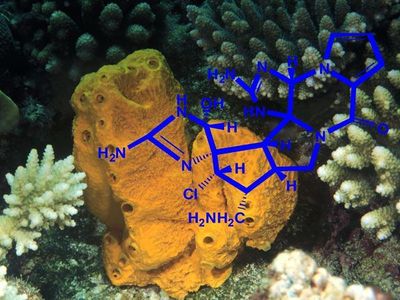Difference between revisions of "Marine Biotechnology securing Human Health"
(New page: In recent years, the chemistry of natural products derived from marine organisms has become the focus of a much greater research effort. Currently there are several products already on the...) |
(ref) |
||
| Line 1: | Line 1: | ||
In recent years, the chemistry of natural products derived from marine organisms has become the focus of a much greater research effort. Currently there are several products already on the market and around 15 marine natural products in various phases of clinical development, mainly in the oncology area, with more on the way. Nevertheless, the seas and oceans represent a huge potential source of new drugs, innovative treatments and diagnostic tools for human and animal health. | In recent years, the chemistry of natural products derived from marine organisms has become the focus of a much greater research effort. Currently there are several products already on the market and around 15 marine natural products in various phases of clinical development, mainly in the oncology area, with more on the way. Nevertheless, the seas and oceans represent a huge potential source of new drugs, innovative treatments and diagnostic tools for human and animal health. | ||
| + | |||
| + | {|align="right" width="300px" margin style="text-align:center; font-size:85%; margin-left: 1em" | ||
| + | |[[Image:mbt_health.jpg|400px]] | ||
| + | |- | ||
| + | |The sponge ''Stylissa massa'' produces an unusual compound palau'amine, with antimicrobial activity. <ref name="Marc Slatter, NOAA-OE">Cayman Islands Twilight Zone 2007</ref> | ||
| + | |} | ||
The main challenges facing pharmaceutical discovery from marine bioresources are linked to: legal aspects (secure access to marine resources and intellectual property rights); quality of marine resources (identification and variability); technology (screening of active compounds and replication, preventing repeated rediscovery); and structural costs of drug discovery from natural products. | The main challenges facing pharmaceutical discovery from marine bioresources are linked to: legal aspects (secure access to marine resources and intellectual property rights); quality of marine resources (identification and variability); technology (screening of active compounds and replication, preventing repeated rediscovery); and structural costs of drug discovery from natural products. | ||
Revision as of 16:20, 1 October 2012
In recent years, the chemistry of natural products derived from marine organisms has become the focus of a much greater research effort. Currently there are several products already on the market and around 15 marine natural products in various phases of clinical development, mainly in the oncology area, with more on the way. Nevertheless, the seas and oceans represent a huge potential source of new drugs, innovative treatments and diagnostic tools for human and animal health.

|
| The sponge Stylissa massa produces an unusual compound palau'amine, with antimicrobial activity. [1] |
The main challenges facing pharmaceutical discovery from marine bioresources are linked to: legal aspects (secure access to marine resources and intellectual property rights); quality of marine resources (identification and variability); technology (screening of active compounds and replication, preventing repeated rediscovery); and structural costs of drug discovery from natural products.
Case studies showing examples of progress
- Marine derived anticancer drugs
- Marine derived painkillers
- Marine derived antibiotics
- Marine derived cosmetics
Recommendations to improve biodiscovery of novel marine-derived biomolecules and the development of new tools and approaches for drug development
- ↑ Cayman Islands Twilight Zone 2007